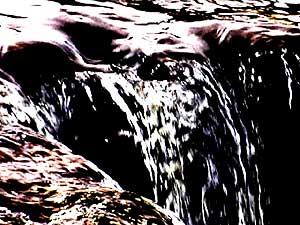|
Audio
Photos
Your Voice
|
A symphony where the audience interacts with more than sound
April 16, 2004
 |
| Rushing water. It's one of the images MCAD students are using in their multimedia installation. (Photo courtesy of Minneapolis College of Art and Design) |
Minneapolis, Minn. — Composer Steven Heitzeg is a very modest man. Ask him about his sprawling, multi-layered Nobel Symphony, and he gives a nutshell description.
 | |||
"The piece's intent is to honor all of the six disciplines or prizes of the Nobel Foundation, and at the same time is, in essence, a symphony for peace and justice," Heitzeg says.
That only begins to describe the Nobel Symphony's ambition and complexity. It's approximately 75-minutes long. There's a movement for every Nobel Prize, from Peace, Literature, and Physics, to Chemistry, Medicine and Economics. It requires a full orchestra, a chorus, a childrens choir and several soloists.
Musicians play instruments from all over the world, including Tibetan singing bowls, and African drums. They bang on empty soup cans to symbolize hunger, and play prosthetic legs to represent the hollowness of war. The words in the libretto were culled from the speeches and writings of Nobel Laureates over the decades. The piece is awash in symbolism and metaphor.
It's a lot for an audience to absorb.
So it's somewhat surprising that Phillip Brunelle, Artistic Director of VocalEssence, which is performing the piece on Sunday, felt the symphony could accommodate a little more.
 | |||
"Not everything in music needs a visual component," he says. "But this piece, it seemed to me, it would be enhanced in a way because of its text."
Brunelle consulted his friend Michael O'Keefe, President of the Minneapolis College of Art and Design. MCAD's interactive media class enthusiastically signed on to the project. The students spent the next four months designing an interactive multimedia installation that would reinforce Heitzeg's musical message of peace and social justice. They wanted to engage the audience before and during the concert. They decided to focus on the symphony's Peace movement.
Concert goers who park in the Orchestra Hall ramp get their first taste of the project almost immediately. As they walk through the skyway toward the hall, they'll be enveloped in a polyphonic collage of Nobel Laureate quotations. MCAD student Mark Fox says the quotations were recorded in English and a number of other different languages.
 | |||
"So that you'll always hear something probably different than what you understand and something that you do understand, as a way of embracing this multicultural pluralistic point of view that Steve Heitzeg had when he made the symphony," Fox says.
Once in the lobby, audience members will see a six by six foot paneled grid or kiosk, displaying several different images. The images represent themes in the the visual assemblage that will be screened during the musical performance. There are photographic images of the sky, birds, people, trees and plants. There's also wooden blocks which have numbers pertaining to particular measures in the composition.
Audience members can hang the blocks next to the images they find thematically appropriate or appealing. They're, in effect, voting on when they want them to appear during the music. With the help of specially designed software, the themes are then selected and edited into the assemblage projected on stage. A similar mechanism exists on MCAD's concert web site.
Interactive Media student Kris Hase says the installation turns audience members into artists.
 | |||
"The audience is determining what happens and what's being shown during the performance, so we don't actually know what the visual performance is going to be," she says. "We have no idea how it's going to fall together."
In another part of the lobby, there will be what the students are calling the summit table. When two audience members sit at the table in quiet peaceful contemplation, two flowers begin to grow on two video monitors. When one of them leaves the table, their corresponding flower withers and dies.
Meanwhile on stage, students are connecting so-called contact microphones next to selected percussive instruments in the orchestra. Each hit on those instruments triggers images that will also be projected on stage. MCAD's Kris Hase says the students hope to involve the audience on new levels.
"It's a really interesting aspect to bring people's choices and people emotions and feelings to these things in a way that normally you don't guage," she says. "And you don't get feedback from your audience except that you know they're clapping or they're sitting or they're not falling asleep or they are falling asleep. It's a way to add to the actual experience of being there."
It might seem there's a possibility the audience will be overwelmed by this bombardment of the senses. But composer Steve Heitzeg isn't concerned.
"I don't worry about that," he says. "I think it's more a choice. There's just simply more choices for the audience member."
Philip Brunelle of VocalEssence looks at the performance as an experiment that will be successful if audience members approach it with open minds. He says it's what live concert going should be about.
"I think the wonderful thing about it is that people will come and be able to say to their friends, I have just been in the most unique incredible experience and you should have been there," he says.
The concert will be performed Sunday afternoon at four at Orchestra Hall in Minneapolis, but those who want to take part in its interactive component should probably get there a little earlier.
|
News Headlines
|
Related Subjects
|
